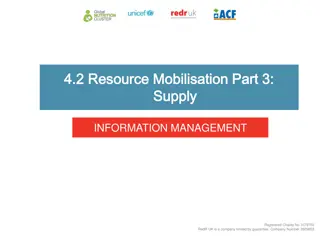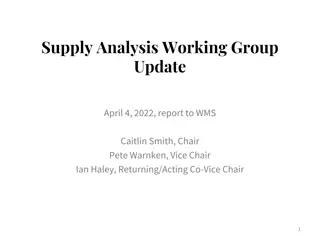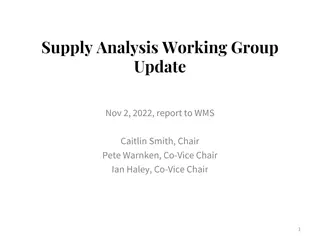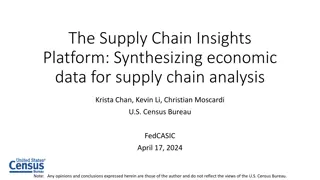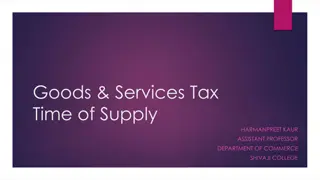Supply Analysis Working Group Update Report
The latest update from the Supply Analysis Working Group presented on April 4, 2022, includes insights on mid-term load forecasting, project success factor analysis, and development cycle trends. The group emphasizes the importance of updating forecast models seasonally and adjusting to weather patterns. The report also addresses the challenges of forecasting during unpredictable winter weather conditions. Key findings highlight the impact of using the coldest weather forecast on load forecasts and the success rates of planned generation projects requested within specific timeframes.
Download Presentation

Please find below an Image/Link to download the presentation.
The content on the website is provided AS IS for your information and personal use only. It may not be sold, licensed, or shared on other websites without obtaining consent from the author. Download presentation by click this link. If you encounter any issues during the download, it is possible that the publisher has removed the file from their server.
E N D
Presentation Transcript
Supply Analysis Working Group Update April 4, 2022, report to WMS Caitlin Smith, Chair Pete Warnken, Vice Chair Ian Haley, Returning/Acting Co-Vice Chair 1
1. Mid-Term Load Forecast Presentation Review All internally developed forecasts (E, E1, E2, and E3) are configured exactly the same: Same exact model Same application of error correction Same application of tuning The only difference is the weather forecast that is used in each forecast model Model Update On a seasonal basis or when weather patterns change, the internally developed forecasts (E, E1, E2, and E3) will be updated with a model that is appropriate for the conditions 2
1. Mid-Term Load Forecast Presentation Using the coldest weather forecast during Winter Storm Landon resulted in a high forecast error for February 4 The actual load exceeded the forecast even though the coldest weather forecast was being used in the selected forecast during the second cold event Winter weather is more unpredictable, has more variability than other seasons Selecting the coldest weather forecast reduces the risk of the actual load exceeding the forecasted load but does not eliminate it 3
2. Planned Project Success Factor Analysis New Planned Report Success rates of planned generation projects Development cycle trends for planned projects (from initial request to operational) Delays to the in-service dates for planned projects Demo https://public.tableau.com/app/profile/ercot.resource.adequacy/viz/ERCOTInterconn ectionQueueTrends/SuccessRatesDashboard 4
2. Planned Project Success Factor Analysis Success Rates and Development Cycle Analysis limited to projects requested between 2002 and 2018 into the ERCOT queue Successful projects are defined as a planned generation projects that have become operational resources only projects with a Full Interconnection Study (FIS) requested included 5
2. Planned Project Success Factor Analysis Success Rates and Development Cycle Analysis limited to projects requested between 2002 and 2018 into the ERCOT queue Successful projects are defined as a planned generation projects that have become operational resources only projects with a Full Interconnection Study (FIS) requested included 6
3. Revamping the SARA Report Goals Increase release frequency for more timely resource updates and fine-tuning of capacity forecasts and scenario assumptions for seasonal peak demand hours Discussing rolling monthly reporting with the PUCT Incorporate probabilistic risk assessment metrics Report multi-hour capacity reserve information to acknowledge net load risks Implement online interactive dashboard with data visualization tools Next Steps This will be a standing discussion item at SAWG Would like to progress on the new report by the end of the year Plan is to keep releasing the seasonal SARA the rest of the year, while working on the revamp 7
4. Resource Adequacy Modeling Projects for 2022 ELCC: Overview: probability-based measure of the reliability benefit of a resource type (or combination of resource types) for the system during periods that have the highest risk of capacity reserve shortfalls estimation is based on probabilistic system simulations, the most common being Monte Carlo forward-looking Objectives: Use SERVM Monte Carlo simulations to do the following: Determine renewable and battery storage ELCC values for individual high- risk hours by season Conduct sensitivity analysis of ELCC values with respect to resource penetration levels, alternative technology types (solar), and grid location Intent is to lay the groundwork for specifying the recommended ELCC methodology for resource adequacy and planning studies Key Milestones: Project completion targeted for 7/30/2022 Study report and SAWG presentation expected in September Next step is to develop Protocol revision request language to integrate into a broader NPRR on revised CDR methodologies 8
4. Resource Adequacy Modeling Projects for 2022 Zonal Study: Objectives: Determine the system reliability and reserve margin impacts of a zonal SERVM model as compared to the current single-zone model design Study Tasks Define load zones in the SERVM model and establish zonal transfer limits Convert the current ERCOT Long-Term Load Forecast into zonal load profiles and assign generating units to load zones Run SERVM simulations for two study years: 2023 and 2026 Compare reliability and reserve margins results to the original single-zone model Key Milestones: Targeting study completion by mid-to-late June Will keep SAWG apprised of the study project Study report and SAWG presentation expected in July 9
4. Resource Adequacy Modeling Projects for 2022 NERC Probabilistic Assessment (ProbA) Study: Overview: Complements NERC s Long Term Reliability Assessment (LTRA) by providing probabilistic reliability statistics of the forecasted resource portfolios reported in the LTRA data submissions ProbA conducted every even-numbered year Two study years: 2024, 2026 NERC Probabilistic Assessment Working Group oversees ProbA scheduling, data submission and reporting procedures The study must include at least one risk scenario Key Milestones Base Case study completion in early August; PAWG peer review of Base Case results completed by 8/23/2022 Summary of ProbA study and Base Case results to be included in NERC LTRA report to be release in mid-December 2022 Scenario risk results due 1/11/2023 for all Assessment Areas ProbA Risk Scenario report released in June 2023 10
5. Additional Study Updates CONE Study NPRR and Study Previous effort to implement a study and methodology to use when a change or update is needed to the Cost of New Entry (CONE) value paused after Winter Storm Uri Will resume discussing NPRR draft at next SAWG meeting Plan to begin study with consultant at the end of 2022 Reserve Margin Study Typically every even numbered year to estimate Economically Optimum and Market Equilibrium Reserve Margins (EORM and MERM), also paused after Winter Storm Uri ERCOT to resume process of procuring consultant for study now Study results expected in mid-2023 11
6. Annual DG Report Major areas of DG growth in ERCOT (Total DG as of 2021= 2920 MW) Solar PV <1 MW Natural gas > 1 MW (co-located with load) DGR Energy Storage> 1 MW 12
SAWG News!! New leadership nomination: Co-Vice Chair: Ian Haley, Luminant Generation Vote at May WMS Next Meeting: May 13th In person + WebEx 13





